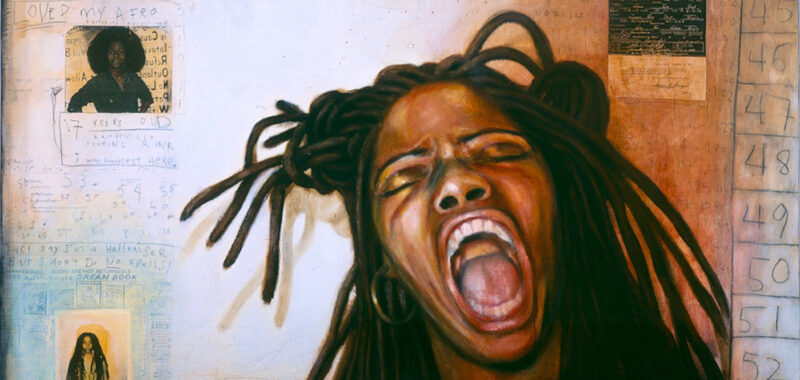How often do you think of music when viewing a visual artwork — a painting, photograph, or collage mounted and framed? Scholar Nikki A. Greene’s new book, Grime, Glitter, and Glass: The Body and the Sonic in Contemporary Black Art, explores this juxtaposition, putting the visual into conversation with the aural and the tactile.
Fittingly, the book’s structure follows the five main components of a song’s composition: “Prelude,” “Verse One,” “Verse Two,” “Verse Three,” and “Coda.” Greene focuses each verse on a single artist — Renée Stout, Radcliffe Bailey, and María Magdalena Campos-Pons, respectively — and dissects specific works in terms of musicality and sonic resonance as much as visual aesthetic.
While the focus seems narrow, each verse does not rest with just one artist. Instead, it ambitiously presents the artist’s particular regional context of Black art, music, and people at large. In order to delve into Stout, for example, Greene frames the realities of the United States mid-Atlantic throughout the 20th century. For Bailey, the American South; for Campos-Pons, Cuba and Caribbean diasporic relations to the US. Thus each chapter blends mini-artist biographies with a socio-political historical account, mapping out a lush and generative artistic family tree. When writing about Stout, Greene references Betye Saar. Much of Campos-Pons’s chapter is dedicated to Carrie Mae Weems. Bailey’s chapter is dotted with connections to Romare Bearden, David Hammons, Todd Gray, and director Barry Jenkins among others.

And then, of course, there’s the music. Complete with an accompanying playlist, Greene maps sonic affect by relating artistic intention to musical artists, identifying musical influences for visual work, and highlighting actual music within work and performances.
In “Verse One,” Greene compares Stout’s use of the physical form and the provocation of Black feminine sexuality in sculpture to that of funk and rock pioneer Betty Davis. For both artists, she draws out the ways in which defiance is often marked by stigma and society’s delayed understanding. “Verse Two” sees a more abstracted effort to explore Bailey’s mixed-media work within the dual reality of Black excellence and anti-Black violence demonstrated by the South, where the late artist was based. Greene first details the music video for hip-hop group Arrested Development’s “Tennessee” (1992) in which Bailey appears, drawing a line to jazz greats Miles Davis (invoking his aforementioned ex-wife Betty) and Sun Ra. “Verse Two” feels slightly unwieldy and disjointed, perhaps due to Greene’s effort to outline the weight of Black masculinity and shine with which these artists wrestle.
More successfully, Campos-Pons’s “Verse Three” tackles the Western lack of recognition of Black validity: in contributions to art, in the power and gift of Black women, in Cuba’s struggle for autonomy, and more. Greene brings in saxophonist Neil Leonard’s heavily researched compositions for Campos-Pons’s work, such as the performance piece Identified (2016), connecting the dots with late Afro-Cuban singer Celia Cruz’s distinctive use of sugar — ¡Azucar! — as a claim of feminine, Black, and Afro-Caribbean power.
For all its feats, this book is ultimately a scholarly work and occasionally veers into academic language. The coda, in particular, is a possibly too-dense display of social theories and observations from Greene.
But while the style demands some additional effort from the reader, it also means that the numerous Black names in the book — of both visual and musical artists — are now forever published and etched into the record of increasingly interdisciplinary approaches to creative fields. Sun Ra’s Afrofuturistic jazz does interact with Romare Bearden’s collage style, which in turn impacts Bailey’s glittering “Pullman” heart. Exploring the sonic grime via funk, glitter via shine, and glass via colonial histories of Black contemporary art through these selected artists, Greene adds a novel component to Black American cultural critique.




Grime, Glitter, and Glass: The Body and the Sonic in Contemporary Black Art (2024) by Nikki A. Greene is published by Duke University Press and is available online and through independent booksellers.

